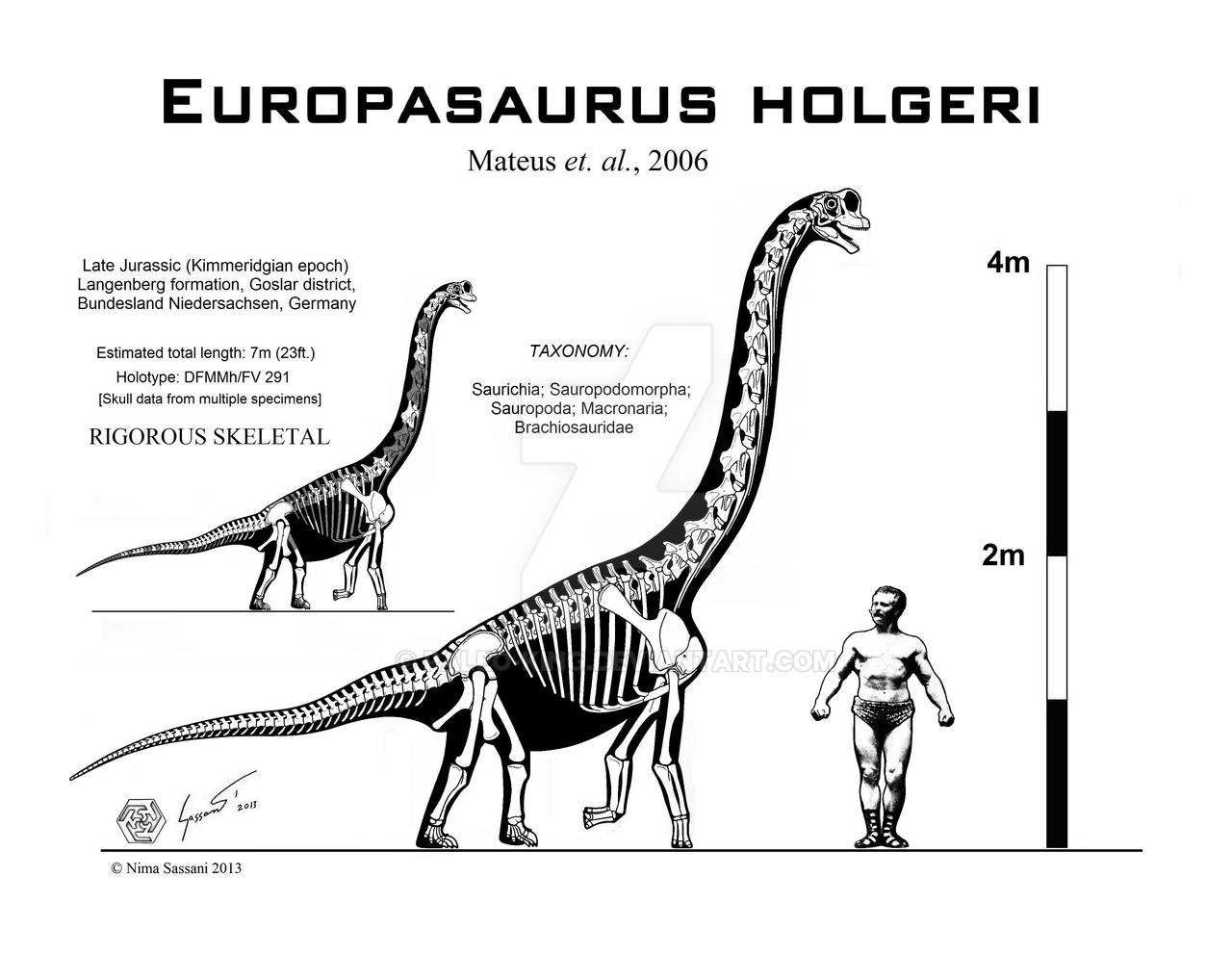ShopDreamUp AI ArtDreamUp
Deviation Actions
Suggested Deviants
Suggested Collections
You Might Like…
Featured in Groups
Description
Europasaurus holgeri
Etymology: "Holger's European lizard"
Time horizon: Late Jurassic, Kimmeridgian epoch (~155 mya)
Length: 7m (23 ft.), perhaps more depending on maturity.
Probable mass: 600-700kg, perhaps more depending on maturity.
YOU KNOW YOU WANT ONE OF THESE CUTE BEASTS ON YOUR WALL... BUY YOUR PRINT TODAY! paleo-king.deviantart.com/art/…
The amazing dwarf brachiosaur (and cutest thing you've ever seen on four legs), Europasaurus holgeri. This animal, a descendant of much larger mainland European brachiosaurs, inhabited a small island which is now the province of Lower Saxony (Niedersachsen) in Germany. At this time, central and northern Europe was a scattered archipelago of small islands, inhabited by far more ocean-hunting pterosaurs and primitive birds than large dinosaurs. While Archaeopteryx was taking flight and Pterodactylus was challenging the maritime air supremacy of the rhamphorhynchoids, dinosaurs stranded on the islands rapidly evolved into smaller sizes to cope with the limited food resources. Europasaurus remains to this day the largest known dinosaur native to Germany.
A number of good skeletons from the original dig site, some still awaiting description, are known of Europasaurus, and may show some measure of sexual dimorphism in the skulls though the postcranial remains don't appear to be dimorphic to any noticeable degree. The skull here is based on the bulbous-crested "male" morphs which so far have not been used in other reconstructions. The rest of the skeleton is the holotype material, which has traditionally been associated with a "female" skull, which has been ubiquitously cast many times over, perpetuating the myth that all Europasaurus skulls were more or less identical.
Europasaurus was a basal member of brachiosauridae, closely related to Lapparentosaurus and somewhat more derived than the atlasaurines. How its giant ancestors arrived in Niedersachsen is still a mystery.
References:
Sander, P. M., Mateus, O., Laven, T., Knötschke, N. 2006. Bone histology indicates insular dwarfism in a new Late Jurassic sauropod dinosaur. Nature 441: 739-741.
Etymology: "Holger's European lizard"
Time horizon: Late Jurassic, Kimmeridgian epoch (~155 mya)
Length: 7m (23 ft.), perhaps more depending on maturity.
Probable mass: 600-700kg, perhaps more depending on maturity.
YOU KNOW YOU WANT ONE OF THESE CUTE BEASTS ON YOUR WALL... BUY YOUR PRINT TODAY! paleo-king.deviantart.com/art/…
The amazing dwarf brachiosaur (and cutest thing you've ever seen on four legs), Europasaurus holgeri. This animal, a descendant of much larger mainland European brachiosaurs, inhabited a small island which is now the province of Lower Saxony (Niedersachsen) in Germany. At this time, central and northern Europe was a scattered archipelago of small islands, inhabited by far more ocean-hunting pterosaurs and primitive birds than large dinosaurs. While Archaeopteryx was taking flight and Pterodactylus was challenging the maritime air supremacy of the rhamphorhynchoids, dinosaurs stranded on the islands rapidly evolved into smaller sizes to cope with the limited food resources. Europasaurus remains to this day the largest known dinosaur native to Germany.
A number of good skeletons from the original dig site, some still awaiting description, are known of Europasaurus, and may show some measure of sexual dimorphism in the skulls though the postcranial remains don't appear to be dimorphic to any noticeable degree. The skull here is based on the bulbous-crested "male" morphs which so far have not been used in other reconstructions. The rest of the skeleton is the holotype material, which has traditionally been associated with a "female" skull, which has been ubiquitously cast many times over, perpetuating the myth that all Europasaurus skulls were more or less identical.
Europasaurus was a basal member of brachiosauridae, closely related to Lapparentosaurus and somewhat more derived than the atlasaurines. How its giant ancestors arrived in Niedersachsen is still a mystery.
References:
Sander, P. M., Mateus, O., Laven, T., Knötschke, N. 2006. Bone histology indicates insular dwarfism in a new Late Jurassic sauropod dinosaur. Nature 441: 739-741.
Image size
3896x3016px 1.2 MB
© 2013 - 2024 Paleo-King
Comments45
Join the community to add your comment. Already a deviant? Log In
This looks really nice.



































